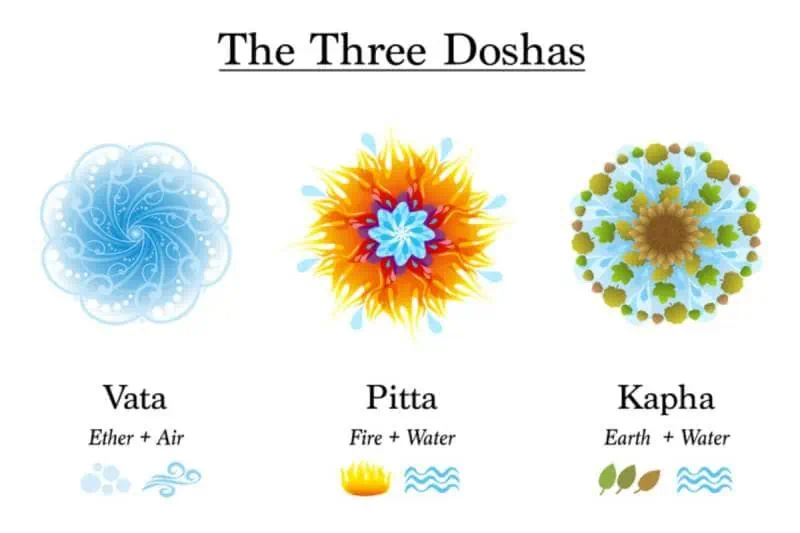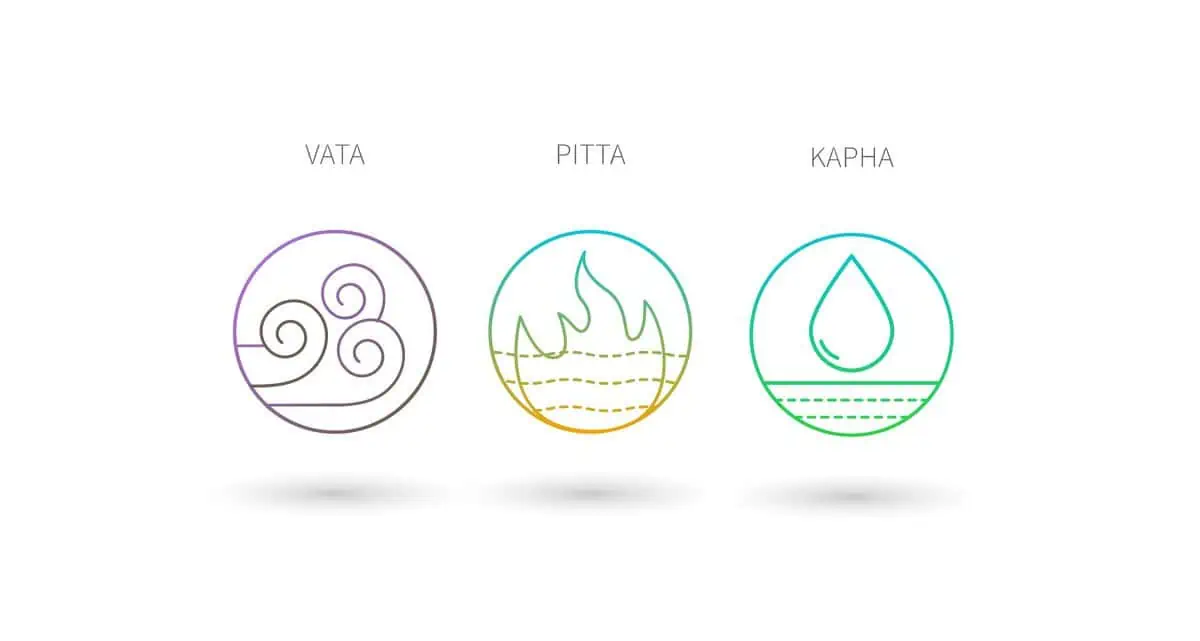Vata Pitta Kapha is the three Ayurvedic principles or body types known as doshas. These three doshas are a foundational concept in Ayurveda, an ancient Indian medicine system that has been around since the 2nd century BC.
Knowing about Vata, Pitta, and Kapha is vital for anyone who wants good health and well-being. By learning how to balance the three doshas, you can improve your energy, relieve emotional stresses and aid physical healing.
So let’s explore Vata, Pitta, and Kapha and how you can work with them to experience greater balance and vitality.
Contents
What Are Vata Pitta Kapha?

According to Ayurvedic philosophy, three energetic forces known as Vata Pitta Kapha exist within us. They influence everything in our minds and bodies, from digestion to energy levels to emotions, and determine our body types and behavioral tendencies.
The three doshas have different properties, including both positive and negative aspects. In short, Vata is the energy of movement, Pitta is the energy of digestion/metabolism, and Kapha is the energy of lubrication and structure.
All three doshas are equally essential to our physiology, but most of us have one or two that are the most dominant. A person’s Dosha dominance is called their constitution or Ayurvedic Body Type. So, for example, you can be a Vata person, a Pitta type, or a Kapha dominant body type.
Although it is an age-old spiritual belief, some scientific research supports the Ayurvedic philosophy. In particular, research has found that our dominant dosha can determine our physical characteristics, behavioral traits, and typical mental and emotional states.
For example, sleep patterns are just one thing that our dosha type can influence. Pitta people are most likely to require less sleep and have higher energy levels. In contrast, Kapha people tend to oversleep and take regular naps.
Determining Your Dosha Constitution
Our dosha type gives us great insight into why we are the way we are. In addition, specific foods and lifestyle habits can help support your unique composition and prevent imbalance. This is essential as an overactive dosha can lead to mental and physical disturbances.
By knowing the qualities and imbalance signs of Vata Pitta Kapha, you can determine which one you are and if there is currently any imbalance. If you want to dive deeper into the doshas, I recommend reading Practical Ayurveda by Sivananda Yoga Vedanta Center.
Vata Qualities

Vata energy combines the air and space elements; thus, it is flowing and spacious. It can be described as light, cool, and dry and is associated with autumn/fall. Vata governs movement in the body and mind. This includes physical processes like blood flow and breathing and mental processes like processing thoughts and emotions.
Physical characteristics of Vata types include:
- A small, naturally thin, lean body type – putting on weight is not easy for these people, even when eating an unhealthy diet.
- Thin bones and skin
- Flexible muscles and high mobility in the joints
- Naturally cold hands and feet, especially during cold weather
- Skin that is dry and cool to the touch
- Small eyes
Mental and energetic tendencies of data types are:
- A clear and alert mind
- The ability to learn easily
- The ability to multi-task
- Good at thinking outside the box
- A lively and dynamic nature, someone who is always “on the go.”
- High creativity
- A free-spirited attitude
- Easily distracted
Signs Of A Vata Imbalance
If you have a Vata constitution, you’ll benefit from the positive qualities mentioned above, like high creativity and fast learning abilities. However, vata types are at risk of having excess Vata energy, which can bring out the negative traits of this energy.
Physical signs of a Vata imbalance include:
- Poor blood circulation, low body temperature, and difficulty staying warm.
- Lack of mobility and cracking joints
- Dehydrated and cracking skin, hair, and lips
- Dehydration
- Digestive issues, such as bloat, gas, or constipation
Mental and emotional signs of a Vata imbalance are:
- A busy, fast-moving mind and difficulty finding mental stillness
- Sleep disturbances and general poor sleep quality
- Anxiety and nervousness
- Constantly feeling rushed or in a hurry.
- Tendency to be forgetful
- Feeling restlessness and finding it challenging to stay still or do nothing
- A sensation of dizziness or ungroundedness.
Pitta Qualities

Pita energy consists of a combination of water and fire elements. It is described as hot, light, sharp, liquid, and mobile. Pitta is associated with the summer and the digestion fire known as ‘Agni’; thus, it governs our metabolism and other transformations in the body.
If you’re a Pitta, you may have the following physical characteristics:
- Medium height
- Naturally muscular, athletic build
- Puts on and loses weight quickly due to fast metabolism
- Soft, greasy, warm skin that may have a reddish, rosy complexion
- Naturally warm body temperature
Pitta types typically have the following personality traits:
- Strong-willed and determined
- Great leadership qualities
- Competitive, goal-oriented nature
- High level of self-confidence
- Sharp, bright intellect and the ability to learn quickly
- Extremely passionate
Signs Of A Pitta Imbalance
Pitta disorders typically occur when the fire element becomes too strong. A pitta person with an imbalance may have the following physical signs:
- Excess heat in the body and constantly feeling hot – Pitta types struggle in hot climates
- Heartburn or acid reflux
- Digestive issues like gas, diarrhea, or constipation
- Inflammation of the joints
- Bad breath
- Excessive sweating and strong body odor
- Very oily skin leading to clogged pores and acne
- Skin diseases such as eczema, rashes, or hives
- Hair loss
A pitta dosha imbalance can also cause the following mental and emotional pitta disorders:
- Anger, irritability, and a short temper
- An aggressive and tenacious nature due to the intense desire to win
- Feeling envious of others
- The need to criticize others
- Unhealthy work-life balance
- Headaches or migraines
Kapha Qualities

Kapha energy is steady, stable, heavy, slow, cold, and soft, consisting of water and earth elements. It is responsible for our physical structure and for creating a sense of grounding and stability in our lives. Physically, Kapha gives substance and support to our body by hydrating the cells, lubricating the joints, and protecting the tissues.
Kapha people may have the following physical characteristics:
- A large body frame with thick, strong bones and joints
- Soft, smooth skin that feels cool to the touch.
- Thick, wavy hair that appears shiny – can also be oily
- Large eyes with thick eyelashes
- A steady appetite
Typical personality traits of Kapha are:
- Stable and grounded
- A calm, polite, empathetic, and caring nature
- Good memory but slow to learn new things
- A preference for slow, passive, leisurely activity
- Speaks slowly – May have a pleasant, deep tone of voice
- Thrives on a predictable diet and daily routine
- Sleeps deeply, requires lots of sleep, and likes to wake up late
- Can gain weight easily
Signs Of A Kapha Imbalance
Kapha imbalances often occur due to excess moisture in the body. Physical signs of imbalance include:
- Constipation or sluggish bowel movements
- Weight gain
- Very oily skin or hair
- Large pores or acne breakouts
- Breathing issues such as asthma or allergies
Energetic, emotional, and mental symptoms include:
- Sluggishness, laziness, depression, and low energy
- Lack of motivation and enthusiasm – a tendency to be a “couch potato.”
- Over-sleeping and needing frequent naps during the day
- Feeling withdrawn and isolated
- Food cravings and emotional overeating
Tips For Balancing Vata

Certain foods can help to increase or decrease a specific dosha’s presence in your being. If you have an imbalance of Vata, consider making the following changes to your diet:
- As digestive issues are a common symptom of unbalanced Vata, choose easily digestible foods like warm oats, brown rice, and eggs.
- Eat warm, moist foods and avoid dry, raw, and frozen foods. Hydrating cooked foods like soups, curries, and stews are best.
- Eat oily foods like avocado, olive oil, coconut, nuts, and seeds, as the oil helps to prevent dryness.
- Choose soft, moist, sweet fruits such as bananas, mangos, papayas, peaches, berries, and apricots. Avoid sour fruits like bitter melon, oranges, and lemons.
- Some mild spices, like cinnamon and cumin, are good. However, avoid overconsumption of spicy and astringent foods.
Aside from nutrition, here are some other ways to balance Vata.
- The Ayurvedic herbal supplement Ashwagandha can help to balance Vata as it reduces stress and promotes a sense of calm. Shatavari is another beneficial herbal supplement for the Vata type as it helps to manage anxiety and relax the nervous system.
- Warm up your body with some warm oil massages. I recommend doing some self-massage using the Banyan Botanicals Vata Massage Oil. It is made with Ashwagandha, Shatavari, and Passionflower and helps improve blood circulation and promote calm and grounding.
- Vata people are typically lively and energetic, but constantly being on the go can cause an imbalance. Thus, adequate rest and relaxing activities like meditation, Yin Yoga, and Yoga Nidra are vital.
- Grounding activities like walking barefoot in nature also help to increase a sense of grounding.
Tips For Balancing Pitta

For a pitta imbalance, follow these nutritional guidelines.
- Pitta imbalance is commonly caused by excessive consumption of alcohol or spicy, oily, fried, salty, and fermented foods. Thus, all these types of foods should be eaten in moderation.
- Cool foods like sweet fruits, dairy products, barley, oats, and mint are great for pitta people.
- Foods rich in bitter and astringent tastes, such as green, leafy vegetables, rhubarb, and rocket, are also ideal.
In addition, the following types will help you reduce excess Pitta.
- If you’re having digestion problems like burning sensations and discomfort in the stomach, I recommend the Banyan Botanicals Pitta Digest Supplements. They contain cooling herbs like Guduchi and Amalaki to pacify Pitta’s heat and mild spices like cumin, coriander, and fennel to aid digestion without overheating the system.
- Triphala Powder is one Ayurvedic herb for the pitta dosha. It improves digestion and cleanses and tones the gastrointestinal tract. In addition, Triphala is therapeutic for the other two doshas and is a rich source of antioxidants. Along with adding it to food, you can mix it with coconut oil to make a face mask. This will help to reduce inflammation, clogged pores, and acne caused by pitta imbalance.
- You can also try inhaling cooling scents like rose, peppermint, and lavender can cool the body and reduce feelings of anger and agitation.
- Slow and dense exercises are best for pitta types, such as weight-lifting, yin yoga, swimming, or hiking.
Tips For Balancing Kapha

By making the following changes to your diet, you can reduce excess moisture in your body while increasing your energy levels and boosting your mood.
- Avoid excessive food consumption in general, as this is one of the most common reasons for a Kapha imbalance.
- Follow a low-fat diet and avoid fried food. Opt for steamed or raw vegetables over stir-fried.
- Choose light fruits like apples and pears over heavy or sour fruits.
- Add heating spices like chili, cayenne pepper, ginger, cinnamon, and cumin to your meals.
Additional lifestyle tips for keeping Kapha under control include:
- The best workouts for Kapha people are intense, vigorous movements like running, dancing, cross-fit, boxing, or Vinyasa or Ashtanga yoga. Kapha types tend to get insufficient exercise as they lack energy, but forcing yourself to get up and move will do wonders in getting the energy flowing.
- Stimulate your body and mind by giving yourself a massage using Banyan Botanicals Kapha Massage Oil. Specially designed for this dosha, it contains invigorating herbs to stimulate your body and mind.
- Drink warming, spicy teas to perk up your energy and spring you into action. Pukka Three Ginger Tea is ideal as it contains ginger, turmeric, and galangal, which all support Kapha imbalance.
Final Thoughts On Vata Pitta Kapha
Vata, Pitta, Kapha, and other Ayurvedic concepts provide a holistic physical and emotional healing method. Knowing your unique dosha blueprint equips you with the knowledge needed to make the right choices for your health and well-being.
Still, as the oldest healing science in history, there is much more to learn about Ayurveda beyond the information in this article. If you’re interested in going deeper, there are many excellent Ayurveda books, such as Ayurveda: The Science of Self-Healing by Vasant Lad.


